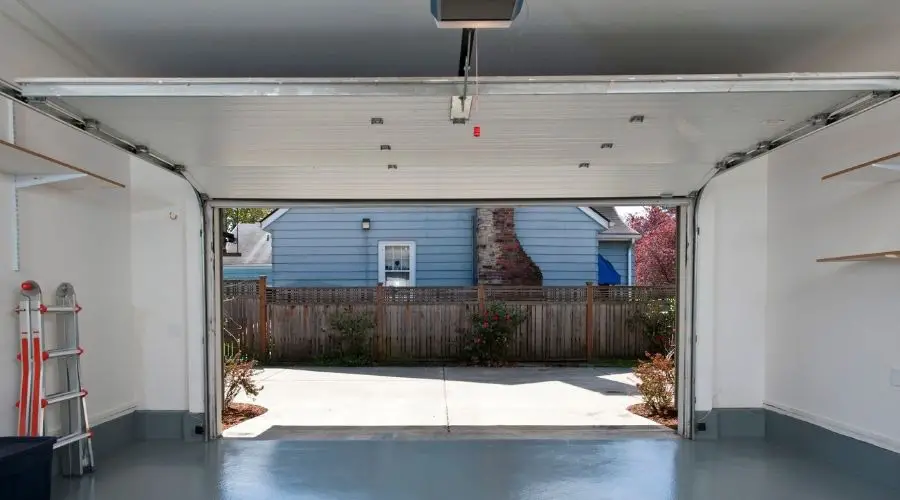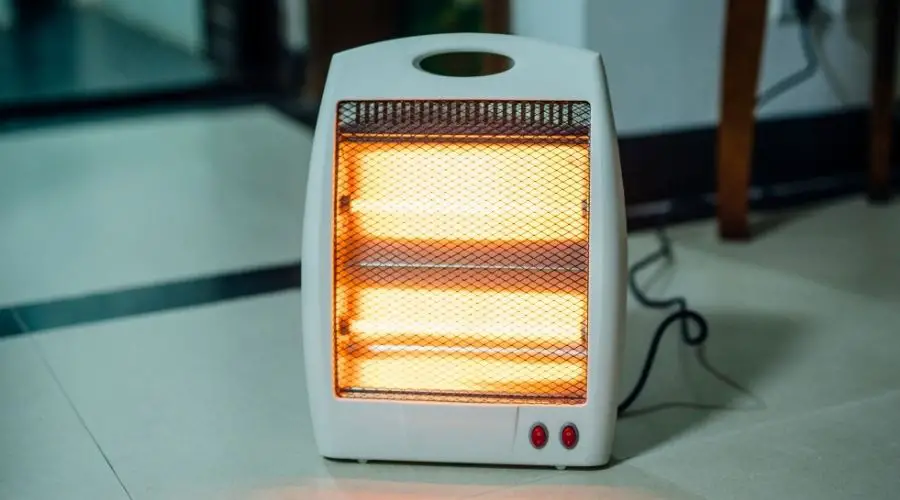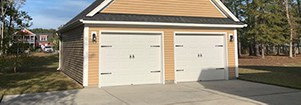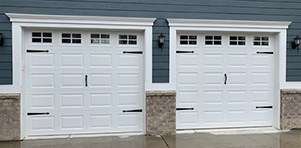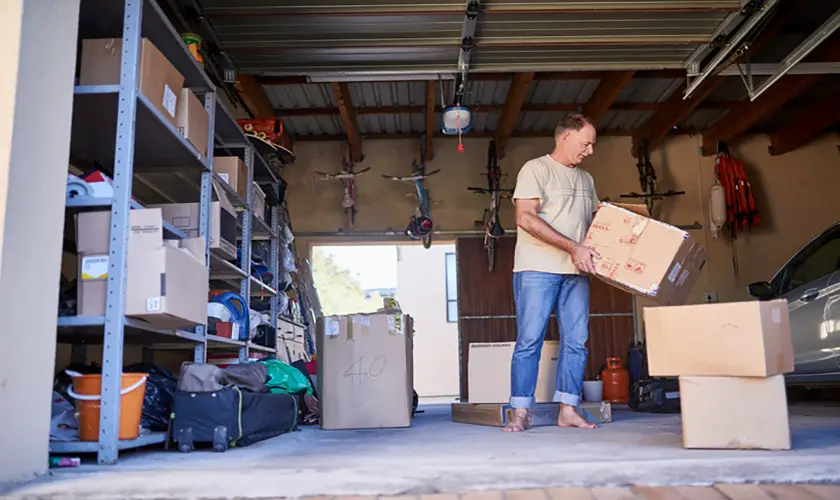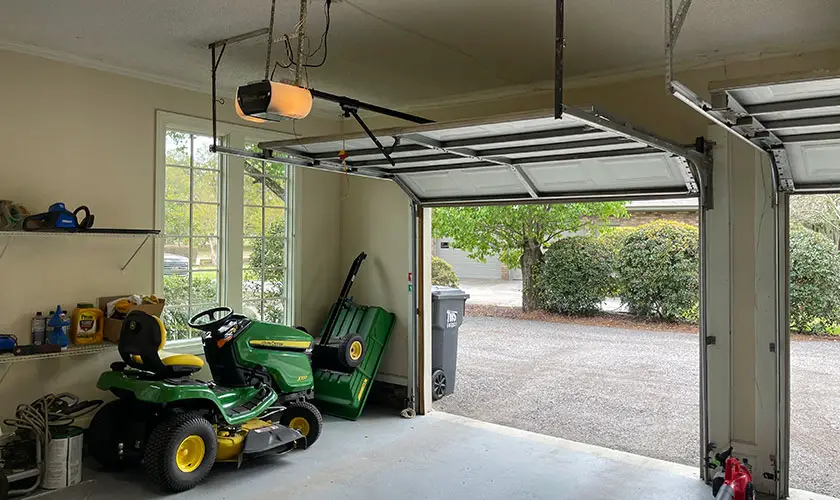

Do Garage Doors Need Maintenance?

How Often Do Garage Doors Need to be Serviced?
How to Do Garage Door Maintenance?
Check the Balance on Your Garage Door
Using the release handle, disengage the garage door from the rail. In manual mode, open the door fully. When fully open, close the door. Does the door run smoothly on the tracks? Next, open the door but stop it halfway. The door should rest in this position.
Call a professional if you think your garage door is out of balance. This can often be misdiagnosed because another door part may be damaged and throw your door out of balance.

Check the Auto Reverse Photo Sensors
First, check to ensure the sensors are free from dirt and debris. Move items away to ensure nothing is blocking the sensors.
Check the operation of the auto-reverse sensors by opening your garage door fully. Then close it and wave a broom handle or your foot in front of the sensors. If working correctly, the door should stop and back up automatically when you break the infrared light beam.
Check the Mechanical Reverse Feature
Some older garage door openers do not have a photo sensor auto-reverse. However, all garage doors have a mechanical reverse feature. This happens when the door is closing and hits an object in its path.
Place an item such as a block of 2″ wood under the garage door path when open. You can also use any other small solid object lying around that won’t easily damage. Position it so that the garage door touches the piece of wood when closing. Close the door. The door should automatically back up once it touches the piece of wood.
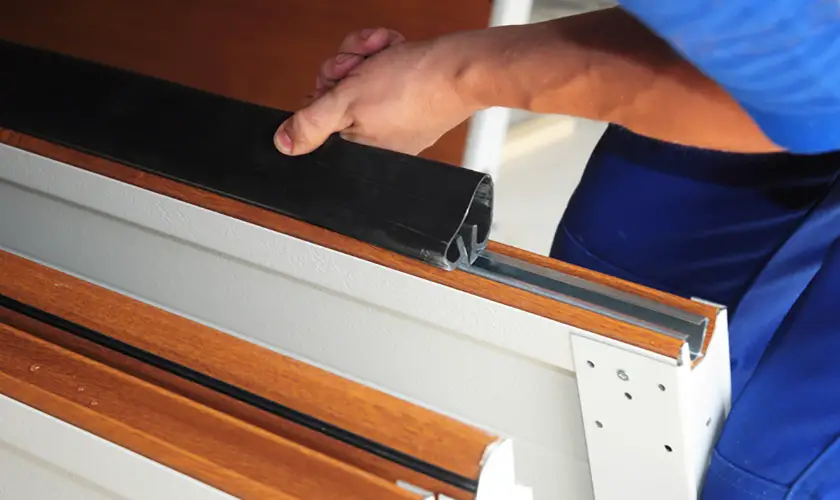
Check the Condition of the Bottom Gasket
The gasket at the bottom of the garage door helps seal the bottom of the door against the concrete to prevent water intrusion and keep out dirt and insects. If the gasket is damaged, dry, or brittle, it should be replaced. This is a relatively simple repair for any homeowner.
Check the Condition of the Weather Stripping
Much like the bottom gasket, garage doors have weather stripping along the side of the garage opening to seal out rain and wind, which could damage your garage door. A wind behind a garage door can severely damage the door requiring replacement. Replace damaged weather stripping as needed.
Check and Lubricate all Moving Parts
With the garage door in the closed position, look at the condition of the springs and pulleys. Do you see any damage to the springs? Did you hear any squeaking when operating the garage door? This is also a good time to lubricate your springs with white lithium grease or lithium-based spray grease.
Check the Condition of the Springs
Garage doors will have either extension springs or torsion springs.
- You can find extension springs parallel along the upper tracks on both sides of the garage door.
- Garage door torsion springs can be found horizontally above the garage door when closed.
Check the Condition of the Pulleys
Look at the garage door’s pulleys for damage and other signs of wear and tear, such as worn edges, cracks, or warping. Pulleys are under a lot of strain caused by extreme tension. Do not attempt to service these by yourself other than a shot of spray lubricant. You should call a professional to help if you think your pulleys need to be replaced.
Check the Condition of the Cables
Look at the condition of the lift cables for signs of broken or frayed strands. Pay close attention to the cables near the bottom of the roller brackets as these deteriorate faster due to wear and moisture.
It is not recommended that you attempt to replace these left cables by yourself. Seek the help of a professional garage door technician. These high-tension cables can be dangerous and cause serious injury.

Check the Condition of the Rollers
Look at the rollers for signs of wear and tear. Depending on the type of rollers, you will determine maintenance. There are four types of rollers in two categories; those with bearings and those without bearings.
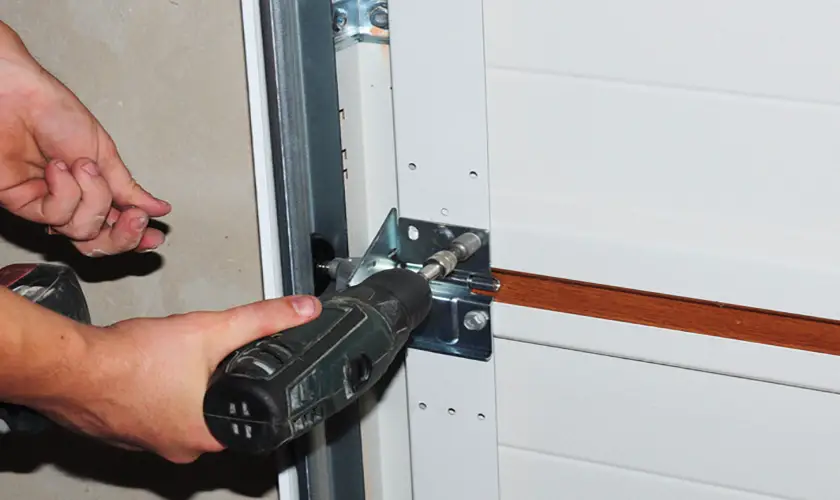
Check the Garage Door Brackets and Hardware
Check the Condition of the Hinges
How Much Does Garage Door Maintenance Cost?
- A broken garage door spring costs $50-$300
- Garage door openers cost $100-$600
- High-tension cables and chains cost $110-$200
- Garage door tracks cost $130-$300
- Wall buttons and remotes cost around $50
- Garage door locks cost $100-$300
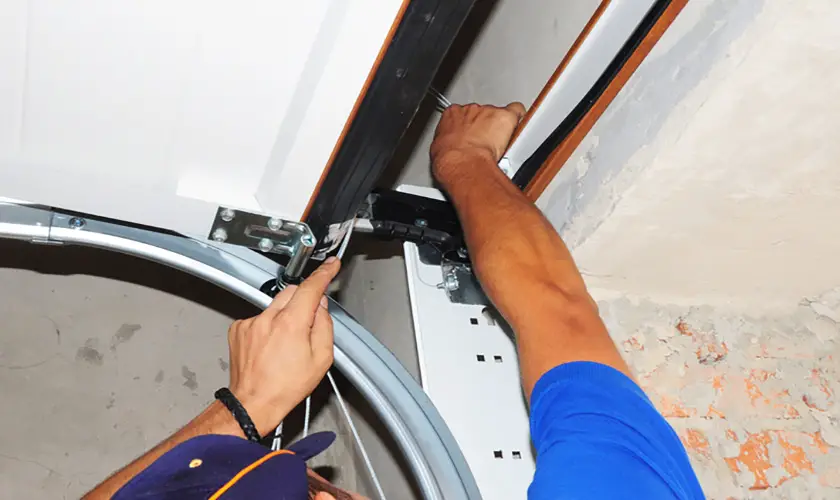
How Long Do Garage Door Parts Last?
Garage doors are not just there to help you get in and out of your garage. A good quality garage door can increase your home’s curb appeal and overall value if you want to sell it in the future. Their appeal might wane badly where they end up pulling your property’s value down. However, garage doors can become damaged through wear and tear, causing dangerous safety issues.
Garage doors can last about 20 to 30 years with preventative maintenance. A garage door’s lifespan largely depends on the material used to make the garage door; steel or aluminum garage doors can last for more than 30 years. Meanwhile, the other components of your garage door, such as springs and rollers, can also last for 10 to 15 years.
A garage door is more than just a door but is an entire system that makes up a whole. That means that you are banking on the garage door itself and on the other parts and components that add up to make it appealing and functional. Let us try to get to know more about your garage door and how long it is expected to last.
Garage doors are an important component of any home. Homes with garages tend to sell faster and for more money than homes without. As mentioned earlier, garage doors have many parts; springs, rollers, tracks, openers, sensors, etc.
The door itself, of course, is the most important piece of the entire system. The typical garage door not only adds function and security to your garage but also adds curb appeal. Garage doors are made from a variety of materials. The list below shows the most common materials.
| Material | Summary Description | Lifespan |
|---|---|---|
| Steel | Paintable. Heavy duty but can be easily dented and subject to rust | 20-30 years |
| Aluminum | Paintable. Lightweight and resists rust. It can be easily dented. | 20-30 years |
| Wood | Built with layers that prevent warping. Available factory-stained or painted. It can also be stained or painted on-site. | 15-30 Years |
| Wood Composite | Have a wood frame covered with fiberboard. Cores are filled with polystyrene insulation. | 20-30 years |
| Fiberglass | Have a steel frame covered with fiberglass. Less subject to denting or cracking. Cores are filled with polystyrene insulation. | 20-30 years |
| Vinyl | Durable and difficult to dent or break. Similar to fiberglass doors. Built on a steel frame and covered with vinyl. Very durable and requires little maintenance. | 20-30 years |
- Steel garage doors can last 20 to 30 years if they are adequately taken care of. Steel garage doors are often made of two layers of galvanized steel that can be primed and painted or covered with composite materials. Steel garage doors are subject to rust and are easily dented. While these doors can damage easily, they are generally very durable. Steel garage doors can be insulated or not insulated.
- Aluminum garage doors can last 20 to 30 years with proper maintenance. Aluminum garage doors won’t rust like steel garage doors but easily dent. They are lightweight and available in several styles and colors. Most aluminum garage doors don’t come insulated. Aluminum garage doors are the most affordable option for budget-conscious shoppers.
- Wood garage doors can last 15 to 30 years. Wood garage doors look more appealing, but they don’t last as long as steel and aluminum doors. Wood doors are built from several layers of wood, which prevents warping. Wood garage doors are available in hardwoods like cedar, mahogany, redwood, and fir. You can purchase these doors factory-stained or painted. They can also be stained or painted on-site. Painting or staining should be done every few years, depending on where you live.
- Wood composite garage doors can last 20 to 30 years. Wood composite garage doors are built with a wooden frame clad with fiberboard sheets. Custom garage doors can closely mimic real wood with realistic grain and groove patterns. The core of the door is insulated.
- Fiberglass garage doors can last 20 to 30 years. Fiberglass garage doors are built with a steel frame with two bonded fiberglass panels. Fiberglass doors resist damage; however, they can break on a high impact, such as a door slamming against concrete. The core of the door is insulated.
- Vinyl garage doors can last 20 to 30 years. Vinyl garage doors are the most durable. Much like fiberglass models, vinyl garage doors are built using a steel frame with bonded vinyl panels and filled with insulation. However, they offer fewer color choices and styles than fiberglass models. Vinyl doors are relatively maintenance-free.
Aside from the structure that makes up the door itself, you also have to look at the other components that make up the entire system.
Garage door openers last about 15 years, depending on the quality of the automatic garage door opener you chose. The better the quality, the more likely it will last longer than 15 years.
Tension springs can last about 10 to 15 years. Tension springs do the heavy lifting whenever you open and close the garage doors. Most tension springs can last somewhere between 15,000 and 20,000 cycles. One open and closing of a garage door counts as one cycle.
Since the average household will open and close a garage door about 1500 times per year, it’s safe to assume you can get somewhere between 10 to 15 years of life. However, the more you use your garage door each year, the lower the tension springs’ life expectancy.
Garage door rollers can last 10 to 15 years. Like tension springs, garage door rollers have a life expectancy based on cycles. The number of cycles is also directly related to the material the rollers are made from.
- Plastic rollers can last 3 to 5 years. Plastic rollers are the most basic roller type and have the shortest lifespan of all rollers. Plastic rollers will only last a few years, likely about 3 to 5 years.
- Steel rollers with ball bearings can last about 10 to 15 years with proper maintenance. Rollers need to be lubricated at least twice per year.
- Steel rollers without ball bearings can last about 3 to 5 years. These are considered builders-grade and will only last a couple of years. These are noisy and, when failing, will jerk badly.
- Nylon rollers can last 12 to 20 years. Nylon rollers vary in quality but are still the quietest rollers on the market. Nylon rollers are the most expensive option.
With all those taken into consideration, you can expect the entire system to last for about 15 years as long as all of the different parts that make up the entire garage door are taken care of properly.

When Should You Replace Your Garage Door?
Even if your garage door is still within its life expectancy, here are some factors that will prompt you to consider replacing it:
Garage Door Is Damaged By Wear and Tear
The average garage door can complete more than 1500 cycles in a single year. That means that your garage door will be under a lot of pressure and damaged because of normal, consistent use. Even the best-maintained garage door will eventually wear out and need replacement.
You also have to consider that the garage door itself is heavy and that the parts that do the heavy lifting might not be able to hold up the weight for a very long time. As such, it is normal to expect your garage door to wear out.
Of course, weather damage can help quicken the wear and tear of your garage door. If you live in an area with hot summers and cold winters or constant rains in your region, you have to expect that your garage door won’t last as long.
Weather adds to and multiplies the regular cycles of normal wear and tear damage. Steel garage doors in coastal areas are susceptible to rust, so fiberglass and vinyl models are more popular.
Garage Door Won’t Open or Close Properly
A garage door that doesn’t open or close isn’t good. Even if your garage door and most of its parts are still in good condition, you should inspect it when you notice it isn’t opening and closing correctly. A garage door that isn’t opening or closing correctly won’t likely mean a complete garage door replacement. Here’s what could be causing your garage door not to operate properly.
Failure of the garage door opener: Garage door openers can appear to have failed yet be okay. If your garage door opener isn’t working, it’s more likely an issue with the remotes or sensors. The garage door opener’s replacement should be a last resort unless there is visible damage to the opener, chain drive components, or lift arm.
Dead batteries in the remote: The batteries in your garage door openers will likely need replacement twice a year. Some remotes that use button batteries may only require replacement once a year.
Failure to the garage door wall console: The garage door opener wall mounted button can fail after a few years. The buttons wear out over time. The wiring between the wall and the wall buttons could have a bad connection needing repair. Also, make sure you didn’t accidentally press the lock button on the wall-mounted remote.
Misaligned auto-reverse sensors: If your auto-reverse sensors located at the bottom of the door tracks are not correctly aligned or covered by dirt or cobwebs, the garage door likely won’t close properly. Start by cleaning your sensors. If cleaning doesn’t work, check to ensure the sensors are aligned correctly.
Garage Door Has Visible Damage
This one should be obvious. Suppose there are clear signs of damage to your garage door, such as visible cracks on the door itself. In that case, you’d have to get it repaired or replaced as soon as possible. It affects the entire aesthetics and could become a safety hazard to you and your family.
Damage to the garage door: if the door is bent, the door panels could be binding, causing the door not to open or close correctly. This generally indicates that the door requires replacement.
Damage to the garage door track: if the garage door track has become damaged, the garage door won’t open or close correctly. Depending on the severity of the damage, the entire door may need to be replaced. However, it’s more likely that only the track will require repair or replacement.
Damage to the garage door rollers: Garage door rollers will likely fail well before replacing the garage door. You can replace rollers without the full garage door replacement being required.
Damage to the tension springs: Garage door tension springs will likely fail well before the time for garage door replacement. You can replace the springs without the full garage door replacement being required.
Garage Door is Old or Lacks Curb Appeal
Even if your garage door is perfectly fine and has no problems whatsoever, you might need to think about getting it replaced because of how old it has become.
Age should be a huge factor in deciding to get your garage door changed because older garage doors tend to have outdated mechanisms and styles. Of course, if you upgrade to a newer and better-looking garage door, it adds value to your property.
A new garage door can also improve the house’s overall curb appeal. Replacing an old garage door can breathe new life into the appearance of your home. If your garage door is still in good condition rather than replaced, a fresh paint job and new hardware may be all you need.
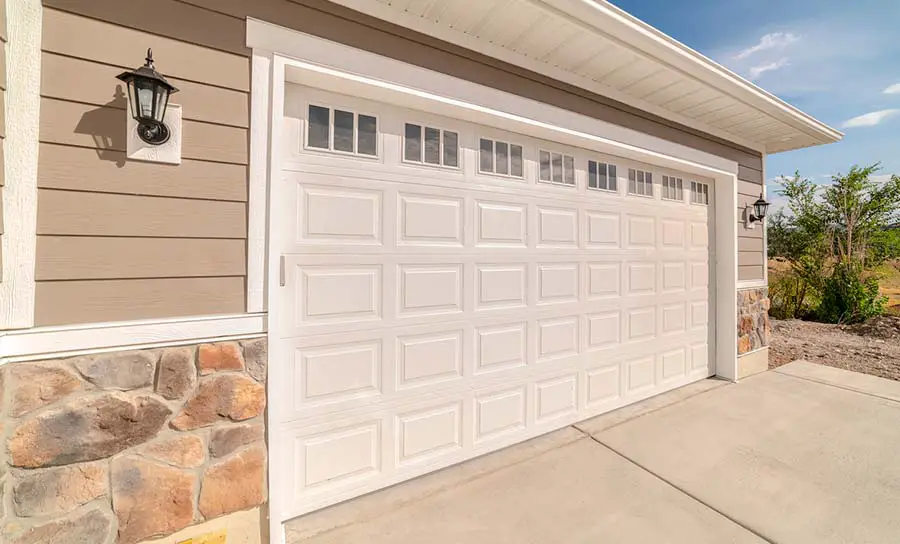
Should You Repair or Replace a Garage Door?
If there are problems with your garage door, it isn’t always a matter of making a quick replacement to the entire system or some parts that need to be replaced. Some garage doors can become perfectly fine with a simple repair job from your trusted repairman.
If you are thinking about getting your garage door repaired or replaced, you have to consider whether the damages are beyond repair. Superficial cracks and dents are easy enough for your repairman to fix.
However, if the entire garage door system keeps breaking down, it might be time to replace your garage door system. It might be best to ask a licensed contractor or a local garage door expert for a second opinion on the matter.
Is a New Garage Door a Good Investment?
Not many people are aware of this, but garage doors can increase your property’s value as long as you keep your garage door maintained and your garage door adds a lot of aesthetic appeal to your house.
This makes a new garage door an excellent investment for your home because of how it can dramatically increase your house’s market value. A new garage door installation has one of the highest returns of investment (ROI) compared to all other home improvements you can make.
A new garage door offers you a high ROI because it is aesthetically appealing and improves the security features of your property. A prospective buyer would always want to have a beautiful and safe home.
What’s the Cost to Replace a Garage Door?
The overall cost of replacing your garage door depends on many factors, such as where you live, the garage door’s size, the electrical work that needs to be done, and the garage door opener mechanism you chose.
Many different factors need to be considered, but I will try to quickly break down estimates to understand how much this endeavor will cost you.
| Garage Door Type | Single | Double |
|---|---|---|
| Steel Garage Door | $500 – $3200 | $1000 – $6400 |
| Aluminum Garage Door | $500 – $2000 | $1000 – $4000 |
| Wood Garage Door | $1000 – $5500 | $2000 – $11,000 |
| Wood Composite Garage Door | $750 – $6100 | $1500 – $12,200 |
| Fiberglass Garage Door | $850 – $3000 | $1700 – $6000 |
| Vinyl Garage Door | $700 – $2100 | $1400 – $4200 |
Steel Garage Door Costs
Steel garage doors vary in cost by the number of layers, whether or not the door is insulated, and the garage door manufacturer. The average price of steel garage doors is $500 to $1800, with customized units averaging about $3000.
Aluminum Garage Door Costs
Aluminum garage doors will cost about $500 to $2,000. Aluminum garage doors are the most cost-efficient of all garage doors. However, they do dent easily but resist rusting better than steel doors.
Wood & Wood Composite Garage Door Costs
Wood garage door prices vary widely because of the varieties of wood, door design, and manufacturer. Wood garage doors will cost about $1,000 to $10,000. Lower price wooden doors are basic and likely unfinished. High-end wooden garage doors are custom cedar, redwood, mahogany, and other species with custom hardware and finishes.
Fiberglass Garage Door Costs
Fiberglass garage doors will cost about $1,400 to $3,000, with custom doors costing about $6000 or more. Fiberglass garage doors are durable and low maintenance as they never need paint. Custom fiberglass garage doors can even mimic real wood.
Vinyl Garage Door Costs
Vinyl garage doors will cost about $700 to $2,100. Some two-car vinyl garage doors can cost $4000 or more. These garage doors are considered kid-friendly, durable, and require no surface maintenance.
Labor to install a garage door costs about $200 to $300 per hour, and one should anticipate a 2 to 8-hour job.
Garage door cables cost about $45 to $100 plus labor. You can purchase a Cable and Pulley Replacement Kit – Two 3 inch Heavy Duty Sheaves on Amazon.
Garage door remote costs about $25 to $80. You can purchase Universal Garage Door Remote Controls on Amazon.
Garage door tension springs cost about $65 to $120. You can purchase DURA-LIFT .250 x 2″ x 33″ Torsion Garage Springs on Amazon.
The garage door opener will cost about $200 to $500. You can purchase Chamberlain Group B1381 Bright LED Lighting Smartphone-Controlled on Amazon.
Conclusion
A garage door should last about 20 to 30 years when properly maintained. I hope we have established the importance of maintenance to protect your garage door’s lifespan, signs that you need to repair your garage door, and when replacement is a good idea – both due to damage or just for an aesthetic improvement.



